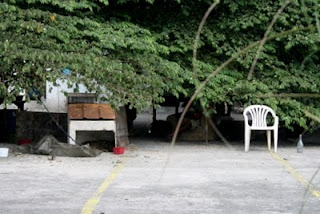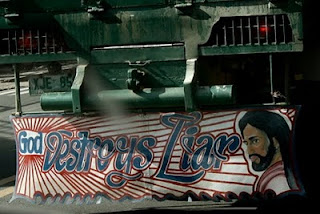
Old-house ogling in San Juan.
Aside from promising street after street of old-house-porn, coming to Batangas gives you all you want-- beaches and coffee. When driving to La Luz to splay yourself out on the sand, you first pass by San Juan, one of the many small, urbanizing towns south of Manila.

Warm fuzzy capiz windows and pointy roofs.
A lot of mid-sized Batangas towns were once fairly small economic activity. They retain a functioning, somewhat organic, layout. Plazas, small streets, old houses, churches that don't look like suppositories, and so on. In eastern(most) Batangas is San Juan,0 originally called Bolbok, from nabulbok or "bubbling" (referring to a "live" stream in the area). Eventually, bothersome flooding from the rivers Bancoro and Bangbang resulted in the transfer of the whole town to its current location.

Not far is the countryside.

Explanation of why the whole town was moved in 1869.
Of course, you will spot an old house that tells you to stop by. It bears the name "Cafeño" in a few different fonts, colors, and forms.

Hey, stop! Cool up in Cafeño!
My favorite being the bold yellow wall with simple illustrations.

A semblance of symmetry on the table.

Plus what?
Inside, you will find a cozy room with small objects collected through the years. The Western strain of cafe, together with a low-key but intuitive assembly of things and offerings illustrates the long-running sliver of cosmopolitan influence among small-town elites.

Old moka pots. Am unsure if they are in use.

Old bottles screenprinted with congressional campaign messages.
You can sit and read magazines while waiting for food that makes you nostalgic for rainy days with lola. Suman (steamed rice cake) with warm panotsa (coconut and raw sugar sauce), cacao with either churros or pinipig (pounded crispy rice).

Cacao with churros. One is a bit burnt, but still tasty.

Suman sa lihiya with panutsa sauce and latik (coconut oil dregs) on top.

Cacao with a siding of pinipig.
An oddity is the collection of several clocks bearing the times of different cities around the world-- a continental touch that seems a folly. The odd selection of cities-- Seattle, Seoul, Toronto, and Paris-- is printed on white paper, cut, pasted on colored paper, and wrapped in plastic, a la school bulletin board.

Time now is as follows.
Cafeño
No.9 Cor General Luna and Rizal St.
San Juan, Batangas










































